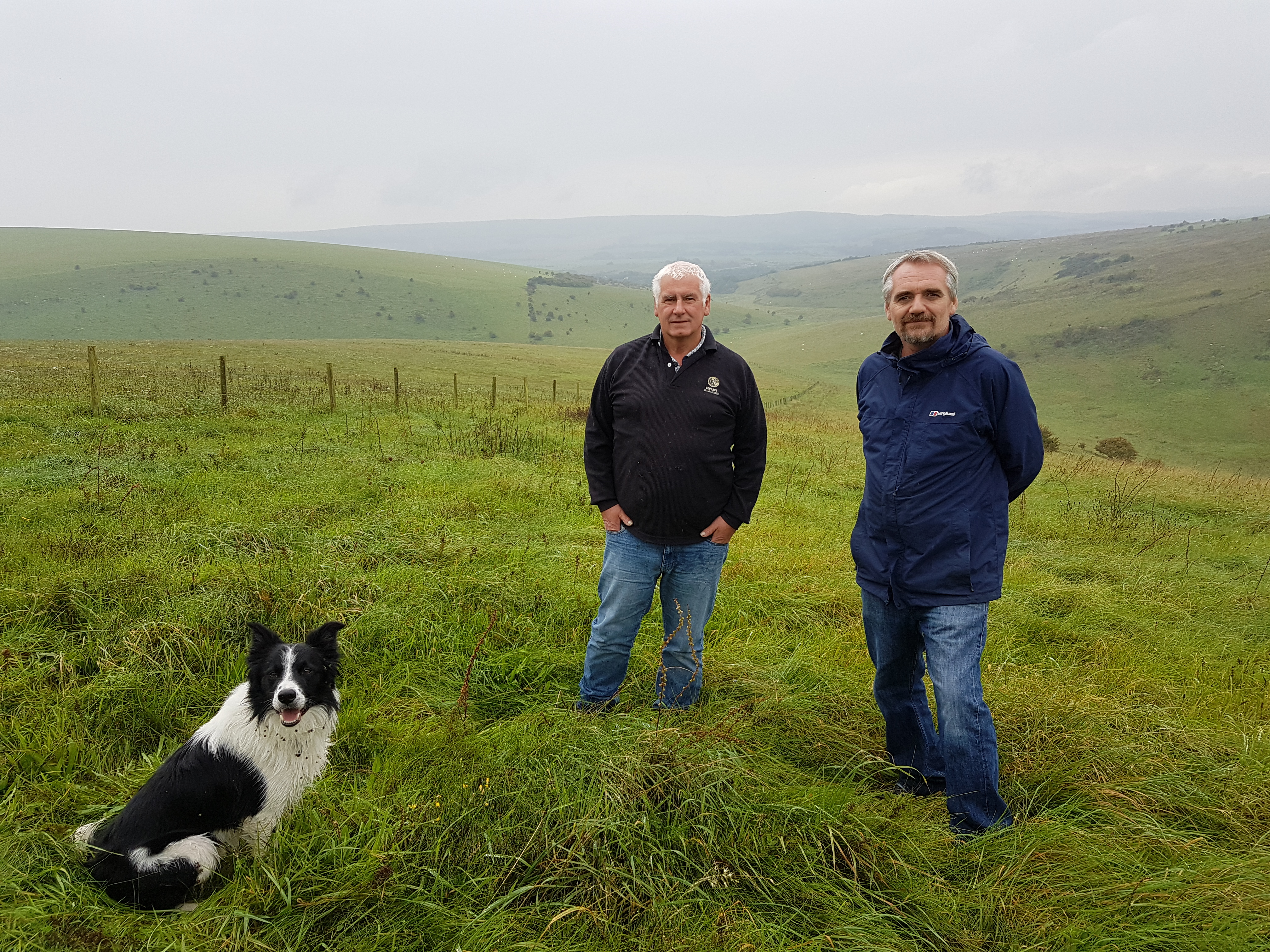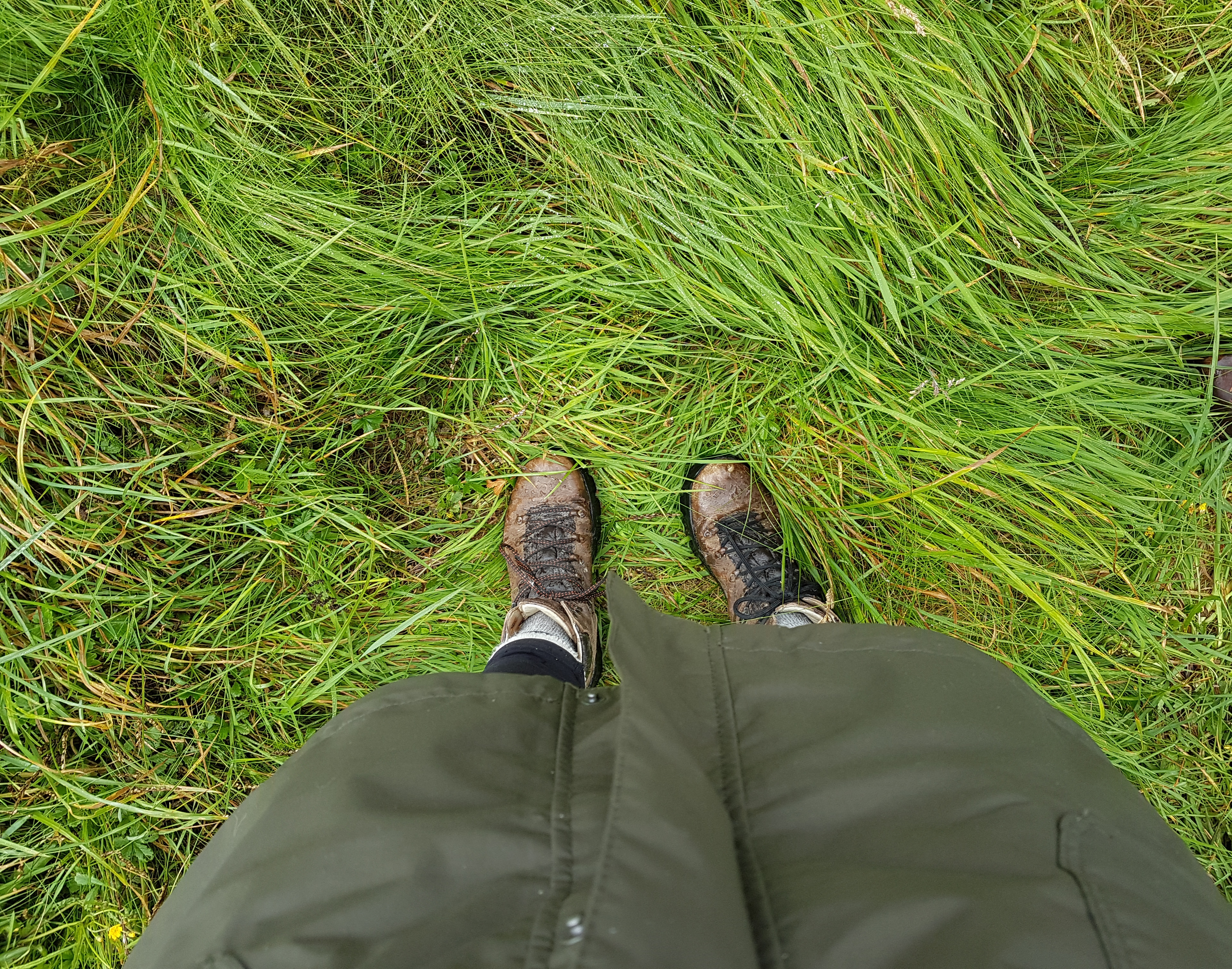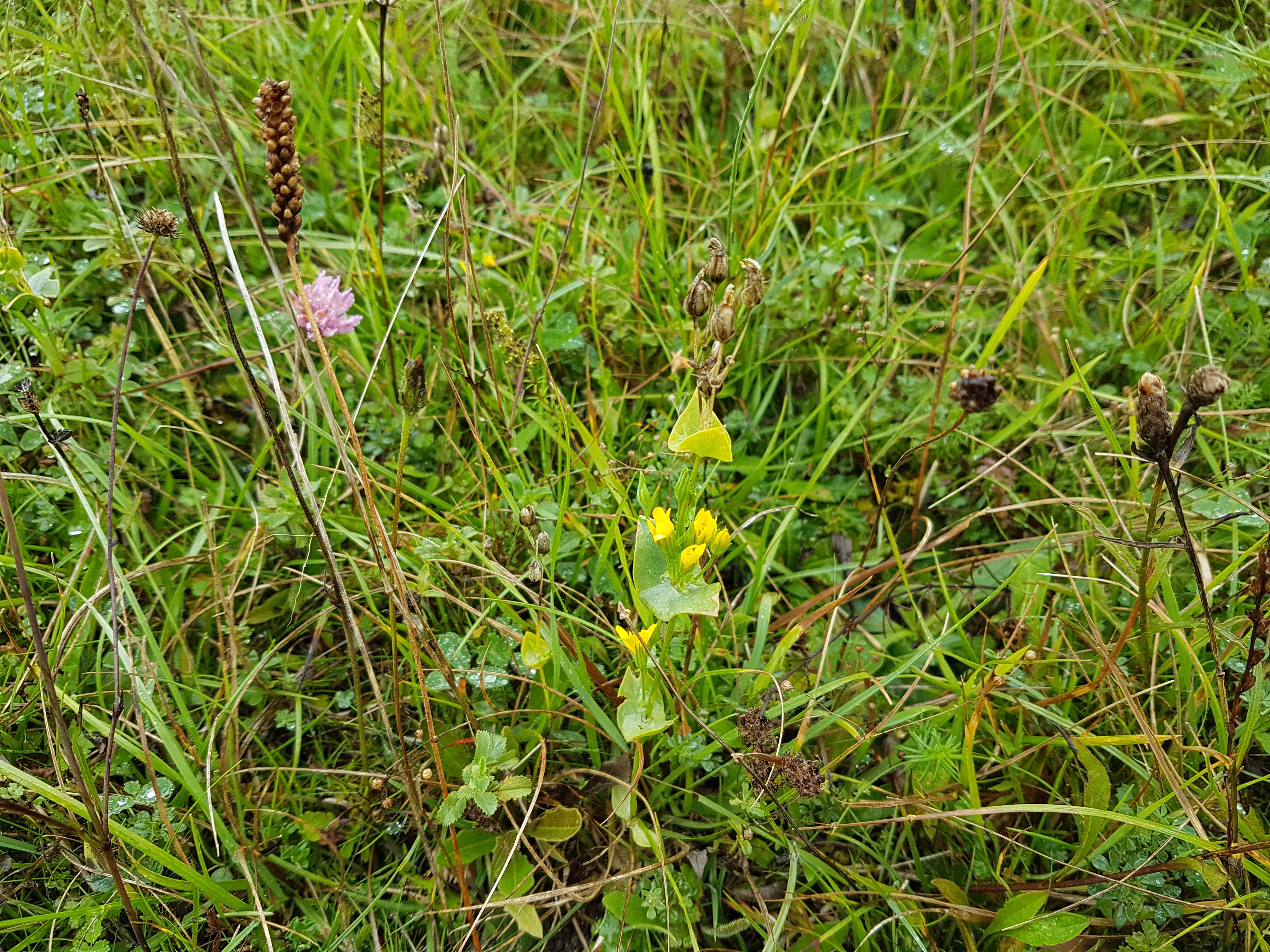How a grazing scheme run by Sussex Wildlife Trust is helping to restore chalk grassland habitats, with Mark, Gary and Chase the dog

I’m not sure what I was doing in 2013 when George Monbiot published his essay ‘Sheepwrecked: How Britain has been shagged by the white plague.’ Whatever I was up to I missed Monbiot’s article until late 2015 when I stumbled across it whilst looking for something completely unrelated.
Long after I finished reading the piece I kept thinking about it. Whilst I am sure the specific case studies Monbiot offers in the essay are factually accurate and provide sound examples to frame questions around the environmental impact and economic validity of sheep farming in those contexts, to use of them to make generalising statements concerning all sheep farming across the UK troubled me.
Life got in the way of my doing further research until earlier this year when I became a member of my local wildlife trust. Through my membership I found out that various grazing schemes are in operation around Sussex and I set out to learn more about this positive aspect of sheep grazing.
On an unusually still, damp September day I drove over to East Sussex where Mark Monk-Terry, a Reserves Manager, and Gary Baldock, Grazing Officer, together with Chase the dog showed me around a beautiful part of the South Downs, Southerham Farm Nature Reserve which includes Sites of Special Scientific Interest (SSSI) and Special Areas for Conservation (SAC).
Can you start by providing some background about how the Trust came to start a grazing scheme here?
This place was farmland that was donated to the trust. Some nature reserves are land that farmers have given up because they cannot make the land financially profitable. Just after the Second World War the grazing in and around the South Downs declined. This was partly due to the fact that fertilisers meant that corn would grow where it couldn’t before. Then the arable farmers found out that even with chemical fertilisers it wasn’t really viable to grow anything on the more difficult slopes of the South Downs. The steepest chalk banks had never been ploughed, so when we came to take over it was easy to see what had been lost to arable farming and use these areas as our benchmark. Another problem for land like this is where arable and grazing have been abandoned, scrub takes over. We needed to find control methods that worked, and that fitted with our ethos. Some people say, why don’t you just get a mower? The answer is that a mower will take the grass and scrub to the same level on the same day. That’s not what we need because it removes all the structure and flowers from the sward in a very short period which is damaging for invertebrates and therefore the birds that feed on them.
How did grazing schemes come about?
By the 1950s there wasn’t a lot of sheep grazing happening here on the South Downs, but rabbits had continued to nibble away at the scrub. When myxomatosis first appeared in the UK in the early 1950’s it decimated rabbit populations. This switched a lot of conservation people on to the issue of grazing because areas of scrub that were being kept at bay by the rabbits began to take over.
Then about 20 years ago there was a gradual realisation by conservationists that had started to take on their own animals and take control of grazing land that this could help with restoring habitats and biodiversity.
How does the Trust decide whether a field or piece of land requires restoration?
For any of the sites that are designated (most of the South Downs have multiple status designations) then Natural England will set targets which will be things like ‘less than 5% scrub’.
The Trust has an ecologist who will survey the vegetation and consider our aims for the site including how much scrub to maintain. We also set up monitoring systems for the site and the ecologist will also look at these mid-season to see if we need a minor change in grazing numbers dependent on how well the sward is doing against the plan for the site.
The Trust has about 18 sites and every one the Trust looks after has an individual management plan for the next ten years according to our assessment of the site’s needs. This plan is reviewed after 5 years. Before these plans get put into action they have to go before a scrutiny committee made up from experts across Sussex. After that, the plans go to Natural England for final approval. In all around 20 people will have looked at our projected plan for the next five years and given approval or further recommendations. Part of my role is to present the plans to the Trust and say “this is what we want to do and now we need to resource it”.
It’s a constant process of fine tuning management, and it’s ok to have ranker patches as long as there is a majority of good chalk grassland. That is what we want to achieve here. For example, right where you are standing is very rich soil and the grasses are dominant. You also need to have some bare ground for invertebrates including ants as there is a relationship between the ants and butterflies, but you won’t get ants up here on this patch because there’s no bare ground.
Also, you wouldn’t be able to achieve restoration with just sheep as you would need so many animals, and you would have to graze all through the year which would then defeat the object because the sheep would also eat the flowering species you wanted to keep.
Does this explain why many farmers can’t undertake this type of grazing?
Well, we are replicating what farmers used to do years ago really in terms of the grazing, with the sheep following after the cattle. The cattle tear with their tongues and take out the longer grass and the sheep come in later and nibble the remaining growth. The old system of folding meant that the sheep were out on the Downs during the day grazing and reducing the nutrients from the soil, and then taken down to the valleys and enclosed overnight to dung. This was a really important way of managing the land.
We don’t fold, but we operate low intensity grazing. This means that in terms of the environment there is enough good dung about for the invertebrates, for the birds – woodpeckers are often spotted taking insects from dung heaps, and fungi – several species of fungi live on dung. You can see how well the dung is being used by the number of holes in the cow-pat. This level of grazing is also good for the sheep and cattle. The animals we have spend their entire lives on our reserves and so they get to learn everything that’s happening in the reserve and pass that on to their offspring. You just don’t get that if you have commercial animals coming in and out all the time. Mixing the Hebrideans with the Herdwicks we noticed that they started to show each other what to do. The Hebrideans bark strip in the winter and we had some Herdwicks up on Levin Down and we thought that’s funny they haven’t stripped the bark, so we put a few Hebrideans with them and then they all got the idea.
There is also the issue that as a Trust we look at the environmental value rather than the commercial value of the land. The activities we undertake have to be resourced. Our commercial outputs are the flowers and butterflies. We’re often told we could utilise niche markets for the meat and wool of the animals we graze. However, that’s not the purpose of the livestock we have. Their purpose is to support the Trust’s conservation work not necessarily to generate income. For example, the wool isn’t great because our sheep have to work hard to forage the scrub. Their wool has got a fair bit of hawthorn and bramble in it. It’s a completely different way of thinking about livestock’s purpose.
Can give me some detail about this site as an example of the work that has been undertaken to restore it and what you are doing to maintain it?
As we look out across this stretch here on the ridge we can see a lot bramble, hawthorn, blackthorn, and some Tor-grass. Tor-grass can be a real problem on the Downs, but the cattle do a really good job on this! You can see by the thick grass that it is slightly ranker up here too.

On original chalk grassland that has never been touched you can get up to 50 different species in a square meter. Imagine a square meter of hawthorn; it may be all right for a few nesting birds, but in the same space you could have fifty nectar sources and the associated species they support.
[We move across ridge]. This bit’s improving, and will catch up with what we want for it with the grazing we will do next year. We need a critical number of animals for the winter; we don’t necessarily need them for the summer as we want to preserve the flowering plants.
[We move about half way down the slope] Here you can clearly see the grass is much finer, and there is not as much of it, so we have more ants and invertebrates. We also have a greater number of diverse plants; I can spot, salad burnet, toad flax, eyebright, mouse eared hawkweed, hawkbit, ragwort, scabious, rampion, tresses, lady’s bedstraw, dyers greenweed, yellowwort, quaking grass. I could go on!

Most of the flowers are perennial and have adapted to sheep grazing, but if you were taking off all your flowering plants every year then your invertebrate cycle is broken. The invertebrates sometimes take a year, sometimes two years. But if you constantly get rid of your flowers you’ve got no nectaring sources and you’re losing the structure the invertebrates need to feed and over-winter on. It’s literally just a case of all the good things are happening here in the summer so we want to let everything flower, reproduce as much as possible and then we slowly take off the growth in the winter, reducing as much as possible to get rid of nutrients.
Obviously the livestock are leaving nutrient in dung but because its been through their guts and been subject to weathering there is a gradual reduction in nutrient over time. The reason you have so many plants in one place is because it is nutrient poor and so they are all fighting or rather they have all adapted little niches to survive. It is highly competitive. If this was really nutrient rich and full of dung like it can be at the bottom of the valley where the land has slipped slightly, then you can find some species such as nettle or thistle can dominate. Up on the thinner soil of these slopes everything is stunted because it is used to being grazed, each species has slightly different mechanisms for holding water or for growing in the shadow of another plant so you get this amazing competition, and that is what we are looking for.
Tell me about the sheep and the cattle, and of course I am bound to ask, why do you not graze Southdowns?
The sheep we have on our sites are Herdwicks and Hebrideans. We chose these breeds because they don’t mind grazing the coarse scrub. They are also hardy sheep and good mothers which means we don’t have too much trouble at lambing time. It would be good to have our local breed the Southdown here, but they eat all the good stuff, preferring the herbage and not the scrub! They also don’t mother as well as the Herdwicks and Hebrideans.
Other conservation projects have started using Herdwicks because they have seen what we’ve done here. They have become a popular breed for conservation restoration. But like all things this isn’t a static situation. For conservation work the sheep need to be hardy and know how to forage. It’s no good introducing sheep, no matter what breed, if they have been brought up on bag food.
The sheep lose a fair bit of weight during the winter, which is natural, although we sometimes get calls from the public saying that the sheep are starving. They’re not they are just not fat. We are all so used to seeing commercial sheep that are fattened for the meat market, that pure-grazed sheep seem thin in comparison.
On this site we will have about 300 sheep through the winter, and about 200 at Malling Down. The bulk of our sheep return here for winter and we have about 50 sheep at Levin Down which stay there all year. Now that we have an established flock it’s a matter of maintaining enough for our grazing purposes. We adjust the numbers of sheep and cattle each year depending on the sites and the percentage of scrub. It’s a constant process of refinement and adjustment. Occasionally we’ll let some commercial sheep graze over winter if we need to keep the grazing up without making our flock too large.
As for the cattle we have both traditional Sussex and British White cows on our sites. The Sussex are a pretty hardy breed and do well on clay and wetter ground. We introduced British Whites from the New Forest recently as they are good at browsing as well as being easy to spot when we’re lookering. We graze cattle across our sites including in the middle of ancient woodlands and pastures; areas that were traditionally grazed and managed by commoners and that whole system dropped away.
As well as checking on the livestock as part of your day-to-day work, I understand that you have a team of volunteers that help out too?
That’s right. We provide a free training session for our volunteer lookerers and have about twenty local people who generally live close to the site they support. It’s great to have those extra pairs of eyes.
As a Trust we are also inviting people into our reserves to see what we do. We are completely transparent about what we do and of course walkers, members of the trust as well as visitors are always keen to help out with passing on information about the livestock as well as wildlife around the sites. It’s a team effort.
Thanks to Mark and Gary from Sussex Wildlife Trust for taking the time to show me around the inspiring Southerham Farm Nature Reserve, and for sharing the story of the various grazing schemes the Trust operates.
Louise Spong is the founder of SouthDowns Yarn and produces woollen spun Southdown wool grown and dyed in the South Downs. You can visit her website at https://www.southdownsyarn.co.uk/ and you can find her on instagram as @louise_sdy and twitter as @SouthDownsYarn